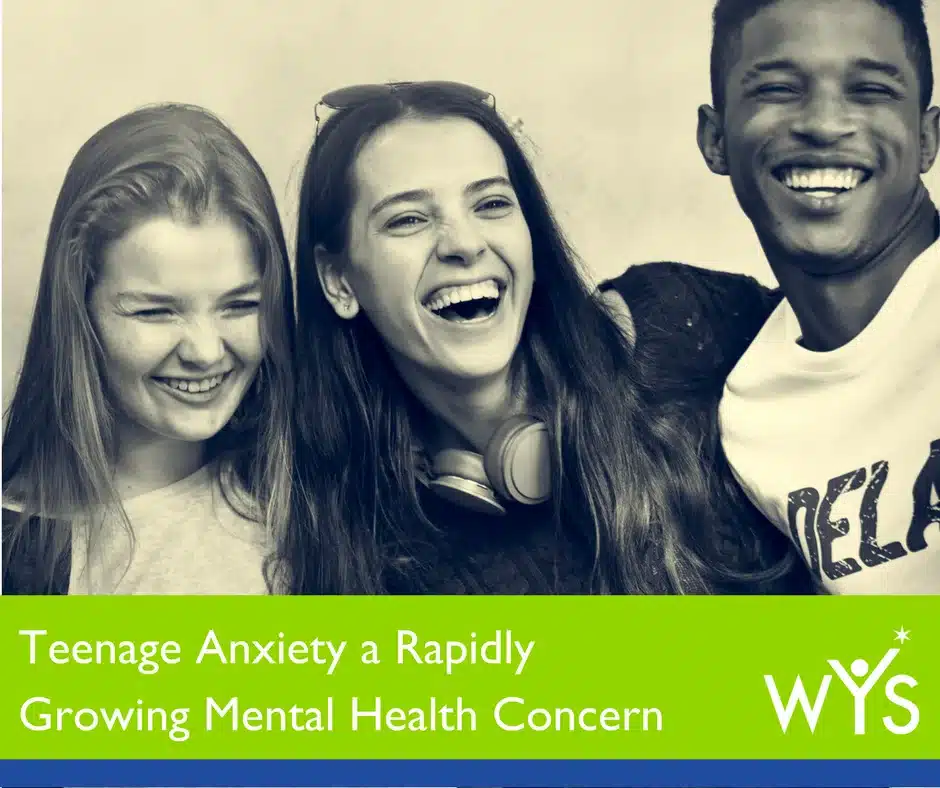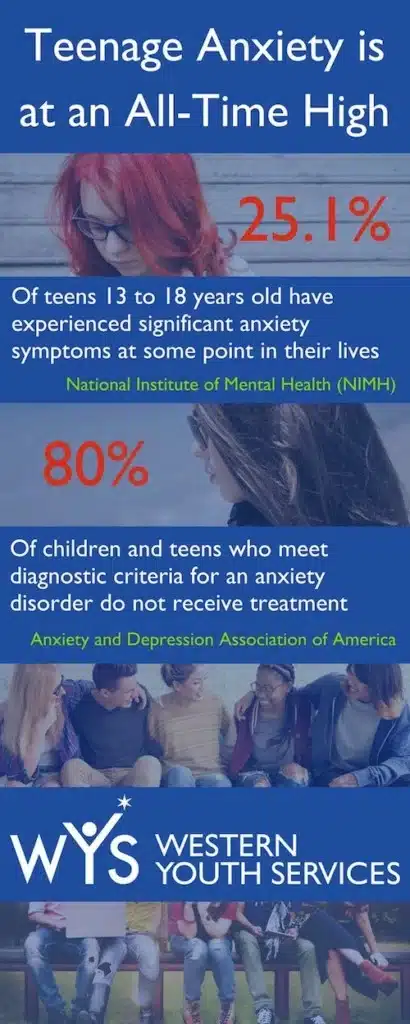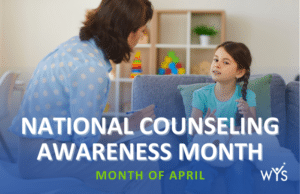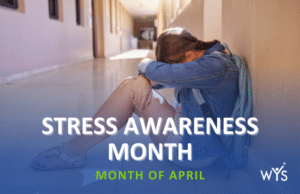
Teenage Anxiety a Rapidly Growing Mental Health Concern
A recent article in the NY Times titled: Why Are More American Teenagers Than Ever Suffering From Severe Anxiety? sheds light on how anxiety is the most common mental-health disorder affecting nearly one-third of both adolescents and adults, according to the National Institute of Mental Health.
“Anxiety is easy to dismiss or overlook, partially because everyone has it to some degree,” explained Philip Kendall, director of the Child and Adolescent Anxiety Disorders Clinic at Temple University in Philadelphia. It has an evolutionary purpose, after all; it helps us detect and avoid potentially dangerous situations. Highly anxious people, though, have an overactive fight-or-flight response that perceives threats where there often are none.
Many teenagers that are living with unresolved adverse childhood experiences (ACEs) such as living in extreme poverty or being exposed to domestic violence, and subsequently toxic stress, experience anxiety. Escape is often their coping mechanism. It makes sense, anxiety triggers their fight-or-flight mode. The outside world is not safe, there can be danger at home, in school, or in their neighborhood. They learn to avoid and/or escape and oftentimes do not talk about it. They fall through the cracks and never receive the help that may very well be available to them.
Struggling in Silence
Although there are many outlets, help for teenage anxiety can land low on the priority list in economically challenged communities. Teenagers that suffer with anxiety often don’t realize how much they are struggling; they think that this is just “the way it is.” You can’t talk about something you don’t have a name for.
It’s difficult for those who have not experienced anxiety to know how debilitating it can be.
Anxiety is more than feeling nervous from time to time, it is a constant presence in the background of a teenager’s life. The severity may strengthen or weaken, but, for those who experience it, it’s almost always there like a shadow. Some days it is suffocating and other days are much more manageable. Teenagers that have chronic anxiety disorder symptoms can become masters in hiding their feelings. It requires tremendous fortitude to hide negative feelings of this magnitude and they direct this strength at making sure that no one knows. It is a lonely and frightening way to live. Imagine what can be achieved if their effort can be redirected to a more positive mindset.
Teenage Anxiety in School
In the schools we have worked with, teachers often talk with us about teens who are outwardly difficult in the classroom, perhaps they are disruptive, bullying other students, involved with substance abuse, or violent in some way. And then there are the quiet ones that are often struggling in silence.
Some schools are set up to celebrate confident, outgoing students more than others. When a student is reluctant to participate in class activities, they are sometimes perceived as a “problem.” What if we turned that around? What if we looked deeper at the quiet ones and were able to identify children and teens that are dealing with stress, peer pressure or intense anxiety?
Signs of Teenage Anxiety

In the hierarchy of mental health issues, teenage anxiety is often overlooked or misunderstood; but that does not mean that people with anxiety aren’t struggling. They just might be struggling in silence.
For many, anxiety is not one of the “acceptable feelings” to have, beginning in childhood, they are taught that to be anxious is to be flawed in some way. This mindset needs a more positive reset.
How can we normalize anxiety and bring it out of the shadows? Below we share several ways to identify teenage anxiety as well as solutions for helping a teen who is experiencing anxiety.
Look for Emotional Changes
- Excessive worry and dread (most days)
- Sudden change in behavior such as impulsive behavior, irritability or restlessness
- Withdrawn and spending more time alone
- Intense fears of things that are not inherently dangerous
Look for Physical Changes
- Trouble sleeping at night, nightmares
- Fatigue
- Complaining of headaches, stomach aches, muscle tension and/or vague pains
- Excessive visits to the doctor or a school nurse
Look for Social and Behavioral Changes
- Trouble focusing in school. Change in grades. Missing school.
- Striving for perfection
- Constantly seeking approval
- Intense fear of social situations
How to Help a Teenager with Anxiety
Anxiety can be overwhelming, especially for teens who even on the best day are contending with teen angst, which can also be a sign of anxiety that is written off as typical teen behavior.
It is a rare case where an anxious teen will say: “I think I have an anxiety disorder.” So as caring adults, whether we are parents, caregivers, family friends, teachers, counselors, professionals, or something else… we need to watch for the warning signs that something is amiss.
Anxiety, for some, may be a lifetime struggle. Life happens… and with that comes positive and negative experiences. Events will happen that trigger something that may have occurred in childhood, even if it has been addressed. One of the best gifts we can provide for our children and teens, is to teach them how to cope, how to manage their stress and anxiety regardless of what comes their way.
Celebrate the Small Wins
Most teens feel social anxiety when meeting new people, trying something new or facing a challenging situation. They can learn to move past this fear by creating a habit of celebrating the small wins and remembering past successes. This practice boosts their self-esteem and each time they successfully venture outside of their comfort zone they will be motivated and inspired to more regularly try new things. It may be something simple like visibly participating in school activities or a bigger challenge. Either way, celebrate their successes together.
Break Down Big Goals
They may be facing a problem that feels too big and as a result feel overwhelmed and do nothing. Teach them how to break down the big problem into smaller, more attainable goals. Focus on how one goal leads to another, use a calendar or a task list to keep track. And of course, celebrate every win along the way regardless of how small.
If there is a missed goal, discuss it, come up with an alternative solution that will still meet the bigger goal. Life is never perfect and course correction is a life lesson that will serve them well in many applications.
Create a Positive Phrase or Mantra
People who struggle with anxiety have a negative loop of conversation coursing through their minds. They are waiting for something to go wrong so they can justify the negative self-talk. Offer them a positive alternative to enlist when they are dealing with a stressful situation. “I am not afraid to try” or “I can do this” are two good examples. These thoughts will take over the negative self-talk (i.e. “I can’t, who am I, I’m too stupid to do this!”) and repeat the positive words to soothe the anxiety and create a habit of positive self-talk.
Reasonable Expectations
Setting unrealistic expectations will set you up to fail. Be mindful of what you expect from the teens in your life and help them to set realistic expectations for themselves. Sometimes trying your best is more than enough. Be clear about expectations based on current capabilities.
Mindfulness, Meditation, and Deep Breathing
One of the treatments that we find particularly successful and easy to integrate into the daily lives of children and teens is Mindfulness-Based Cognitive Therapy (MBCT) which is designed to help people who suffer with repeated bouts of depression, anxiety, and chronic unhappiness. It combines the ideas of cognitive therapy with meditative practices and attitudes based on the cultivation of mindfulness.
Mindfulness is closely tied to meditation and deep breathing. It teaches you how to change your relationship with the cause of your anxiety. One teacher in NYC who incorporates mindfulness into the school day asked his students what mindfulness means, they tentatively responded: “being focused,” “being aware of our surroundings.” He nodded in agreement, but added that it was also “being aware of our feelings, our emotions, and how they impact us.”
Jon Kabat-Zinn, the biologist who first coined the term “mindfulness” in the ’70s, defines it as a state of mind: the act of “paying attention on purpose”. Again, these are life-altering practices that when integrated early in life, can create a lasting impact by holistically rewiring the brain and helping children and teens who are starting out against all odds have a tool they can always utilize regardless of what they are up against.
There are several ways that mindfulness, meditation, and breathwork can be incorporated into school life, home life, and as part of a mental health treatment plan.
Meditation Apps
There are many apps to choose from, two of the most popular are:
Insight Timer: This is a free app available on both the Andriod and iOS platforms that has thousands of meditation recordings that can easily be listened to via headphone for an individual experience or on speaker phone and shared with others. They have specific meditations for a desired result and ones for children. You can save your favorites and create meditation goals.
Headspace: This app, also available on both the Andriod and iOS platforms, has both free and paid plans. It is a more interactive experience and the paid plans have meditations specific for children up to age 5. Their slogan is “We’ll show you how to train your mind for a happier, healthier life.”
Deep Breaths
Perhaps meditation is too much of a stretch. A simple habit to teach is to close your eyes, take a few deep breathes, count to three and open your eyes. This easy technique can often help to quiet an anxious mind and center thoughts.
At Western Youth Services, mindfulness-based techniques are integrated into the wide variety of services we offer. All service formats such as groups, individual therapy and family sessions incorporate the core belief that recognizing the nature of emotions in order to act on them more carefully helps our clients understand the nature of their thoughts assisting them in letting go of those that are harmful to self and other and improving awareness of physical sensations to promote well-being. This belief and integration into our services executed by empowering our clients and their families with knowledge, tools and fun enjoyable opportunities to practice skills cultivates emotional regulation, self-development, stress reduction and supports academic performance through strengthened attention. Once learned and practiced our clients are equipped to bring these skills into their everyday life.
When to Reach out for Professional Help
If a child or adolescent in your life is exhibiting a majority of the signs listed above, please seek professional help. If you are in the Orange County, California area, contact a mental health professional at WYS. If you believe that you or a loved one is currently at high-risk, call 911 or immediately transport them to a hospital to receive care.

Lorry Leigh Belhumeur, Ph.D.
Chief Executive Officer
Western Youth Services






